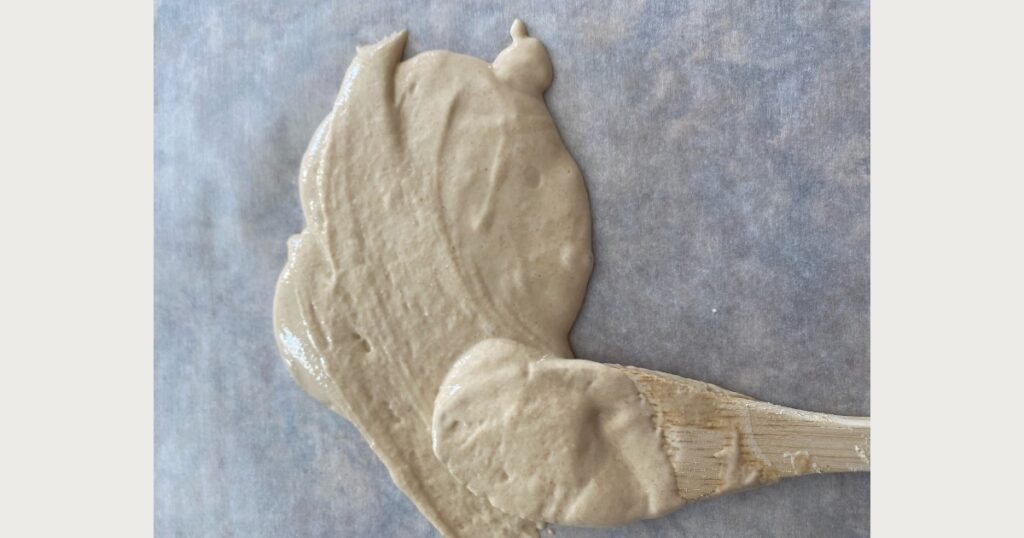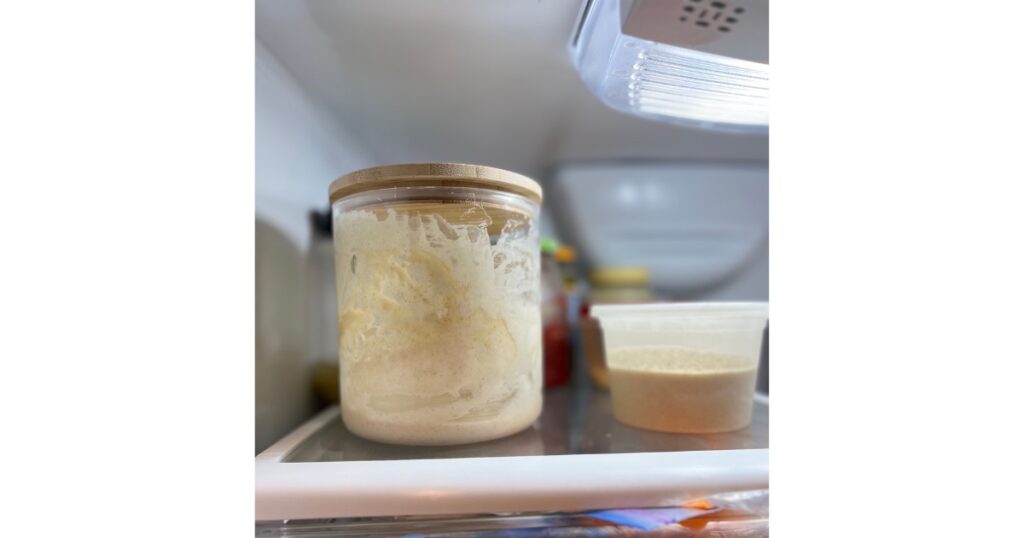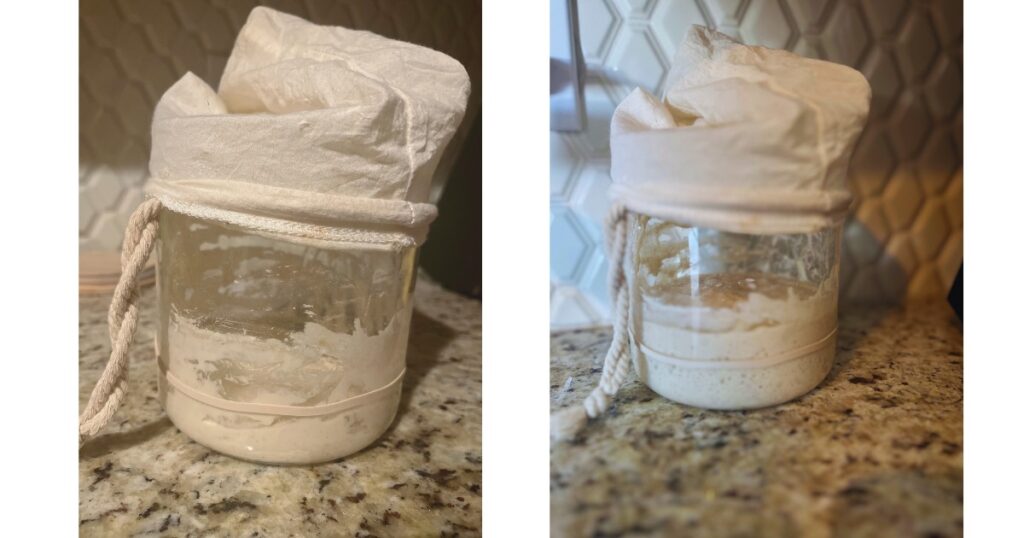Learn to create a dried sourdough starter for long term storage. Easy to prepare and maintain for quick revival from a dehydrated state. Never run out of sourdough starter again!

After creating a sourdough starter from scratch, use sourdough discard in recipes like sourdough bread, cinnamon rolls and bagels. To maintain your sourdough starter for years to come, you can use preservation methods including the countertop method, fridge method and freezer method. But did you know you can dry sourdough starter for long term preservation?
Creating a dried sourdough starter is a great way to maintain your sourdough starter. By doing so, sourdough fits your schedule and lifestyle.
Drying sourdough starter makes it easy to share with others. And it gives you flexibility should your sourdough starter jar fall off of the counter and shatter into a million pieces.
Tools for Drying Sourdough Starter
There are a few tools needed to dry sourdough starter. Once you have sourdough starter, use one of the below preservation methods to create a dried sourdough starter for later use.
- Sourdough Starter
- Flour and water (to feed sourdough starter)
- Glass Jar
- Sheet Pan
- Parchment Paper
- Plastic Bag

How to Dry Sourdough Starter
All dried sourdough starter is created the same way. The process begins by feeding your sourdough starter, allowing it to come to peak hydration, encouraging it to dry and then storing it for long term preservation.
To collect dried sourdough starter over time, consider any sourdough discard waste. The dried pieces can be classified as the ‘crispy bits’ of the sourdough starter which are left over on the side of a mason jar / storage container or any remnants leftover on a utensil used to stir the starter.

Alternatively, to make a larger quantity of dried sourdough starter at one time, take the amount of sourdough starter you wish to dry, spread a thin layer over a piece of parchment paper on a sheet pan and allow it to dry at room temperature.
To keep anything from falling into the sourdough starter (IE hair or anything else which is airborne), spread the starter between two pieces of parchment paper.

Once dried to the touch, break into smaller pieces and store. You can also blend the smaller pieces of dried sourdough starter in a mixer to create a powder. Regardless, this step will not impact how to revive dried sourdough starter.
It is important to consider to dry sourdough starter at room temperature. It can be placed under a fan or an open screened window to increase the speed of drying time.
Finally, do not place the sourdough starter in a dehydrator or oven to speed up the drying process. Yeast dies at a temperature of 120 degrees fahrenheit, which is below the standard temperature of a dehydrator (at 130 degrees fahrenheit).
Too much heat will stop the preservation of good live bacteria we love in sourdough. This will cause the starter to be inactive and it will not reactivate when revived.
Dried Sourdough Starter – Preservation Methods
To dry sourdough starter, chose the preservation method (below) which works best for you. Simply, feed your starter (to ensure it is active) and allow it to dry before placing into a storage container for future use. There are plenty of methods to create dried sourdough starter include the below methods (I.E.):
- Place in a glass jar
- Place within a freezer-safe container
- Place within a plastic bag

It is easy to preserve dried. The first step is to dry the sourdough starter and break into small pieces or blend into a powder with your blender or food processor.
Place the dehydrated starter in a clean jar or freezer safe airtight container. Allow enough room for expansion (IE 80% full) and place within the freezer. The dried sourdough can also be placed in a freezer plastic bag.

How to Revive Dried Sourdough Starter
Reviving and reactivating dried sourdough starter is easy. It really reminds me of the first few days of beginning a sourdough starter from scratch. The only difference is the first day you have some dried sourdough to ‘kickstart’ the process.
First, weigh out as much sourdough starter as you would like to reactivate with your kitchen scale (we tend to do 1 ounce at a time). Allow the sourdough starter to sit within the same amount (1 ounce) of warm water for 3-4 hours. Cover with a tea towel or plastic wrap and allow to sit at room temperature.
Next, stir in an equal ratio (1 ounce) of fresh flour. The type of flour does not matter much. The first feedings can be all purpose flour, bread flour or whole wheat flour.
For example -1 ounce dried sourdough starter, 1 ounce water and 1 ounce flour. Place at room temperature (I.E. a warm spot out of direct sunlight).
On the next day, feed 1.5 ounces flour and 1.5 ounces water. Cover and allow to sit at room temperature. You may see signs of the fermentation process occurring as it reactivates (little bubbles!).
On the third day, discard half the starter and feed again (1:1:1 ratio – 1 ounce existing sourdough starter mixture plus 1 ounce flour and 1 ounce water). You are on your way to a mature starter!
At this point, reactivation should have occurred and you have a new starter. If it needs a few more days to reach peak activity (double in size or pass the float test), continue discarding half and feeding a 1:1:1 ratio of flour and water.
The whole process could take up to 5-7 days (or less time) depending on the temperature of your home for the starter to regenerate. Finally, continue regular maintenance feedings as usual and increase the amount of starter by feeding what you need for a recipe.
We like to keep our starter small to avoid excess starter and having to feed it a cup of flour. For example, if you have a recipe which calls for 6 ounces of sourdough starter, begin with 2 ounces of sourdough starter (regenerated from dried status).
Next, feed with equal parts water and flour (so 2 ounces starter, 2 ounces water, 2 ounces flour). Use with your next recipe!
If you are concerned about the integrity of your sourdough starter, consider utilizing the float test or rubber band test to ensure optimal hydration levels.

Frequently Asked Questions
How new can a sourdough starter be prior to dehydrating it?
Optimally, mature sourdough starter should be created before it is dehydrated. Because maintenance methods for starter vary (fridge vs countertop), I hesitate saying a timeline – I.E. 5 months.
Ideally, the sourdough starter would be used to make baked goods which are rising when active sourdough discard is used. Additionally, the sourdough starter would double in size when fed on a regular schedule. And the sourdough starter passes the rubber band test and or float test prior to using and baking.
The purpose of dehydrating a mature sourdough starter is to ensure the wild yeast cultures are mature.
Can you dehydrate sourdough discard?
This blog article explains how to dry sourdough starter. By following this tutorial, you will have active sourdough discard.
It is important to ensure you have an active sourdough starter. It should be at peak (100% hydration). This will ensure the best results when rehydrating the starter.
Is sourdough starter healthy after dehydrating? Does drying starter damage sourdough bread?
Drying sourdough starter preserves the integrity of sourdough starter and sourdough bread without causing any damage. Sourdough bread created from a dried sourdough starter works well, making it a reliable backup option for future use.
How to use dried sourdough starter?
Dried sourdough starter can be used within any recipe requiring sourdough starter. It can be used in sourdough recipes like (but not limited to) biscuits, cookies, bagels, cinnamon rolls and of course bread. can be used just as any other sourdough recipe would.
Additionally, share dehydrated sourdough starter with others. A commercialized dried sourdough starter example would be: Ballerina Farms Sourdough Starter Kit (Willa Sourdough Starter).
What is better – freezing or drying sourdough starter?
Freezing and drying sourdough starter are excellent methods for preserving it for future use. These approaches offer convenience by ensuring that sourdough starter is readily available when needed.
Both methods require a comparable amount of time for preparation and revival, making them equally efficient. Moreover, they serve as long-term storage solutions for food. If access to a freezer is unavailable, drying sourdough starter becomes the preferable choice.
How long can dried sourdough starter be stored for?
The shelf life of sourdough starter is technically infinite. Additionally you can also freeze the dried starter for more years for additional ‘life’.

Dehydrate Sourdough Starter
Equipment
- Parchment Paper
- 1 Sheet Pan
Ingredients
- 1 Sourdough Starter
Instructions
How to Dry Sourdough Starter
- Collection method:To collect dried sourdough starter over time, consider any sourdough discard waste. The dried pieces can be classified as the 'crispy bits' of the sourdough starter which are left over on the side of a mason jar / storage container or any remnants leftover on a utensil used to stir the starter. Through time, collect these pieces and place within a clean mason jar or plastic baggie.
- Parchment Paper method (Air dry): To make a larger quantity of dried sourdough starter at one time, take the amount of sourdough starter you wish to dry and spread a thin layer over a piece of parchment paper on a sheet pan.Allow it to dry at room temperature. To keep anything from falling into the sourdough starter (IE hair or anything else which is airborne), spread the starter between two pieces of parchment paper.Once dried to the touch, break into smaller pieces and store. You can also blend the smaller pieces of dried sourdough starter in a mixer to create a dried sourdough starter powder. Speed Up Process – Fan/Window:To speed up the parchment paper method, consider placing the sourdough starter under a fan or an open screened window to increase the speed of drying time.
How to Revive Dried Sourdough Starter
- Day 1: First, weigh out as much sourdough starter as you would like to reactivate with your kitchen scale (IE 1 ounce). Place dried sourdough starter in equal part (1 ounce) of lukewarm water for 3-4 hours out of direct sunlight. Cover with a tea towel or plastic wrap and leave on counter.Next, stir in an equal ratio of fresh flour. Allow to sit until next morning (24 hours).Total starter will have 1:1:1 ratio – 1 ounce dried sourdough starter, 1 ounce water and 1 ounce flour.
- Day 2: Feed starter mixture an additional 1.5 ounce water and 1.5 ounce flour. Cover with tea towel or plastic wrap. Allow to sit at room temperature until next morning.
- Day 3: Discard half the starter mixture. Feed flour and water in 1:1:1 ratio – 1 ounce sourdough starter (remaining) PLUS 1 ounce flour and 1 ounce water.
- Days 4-7: At this point, reactivation should have occurred and you have a new starter. If it needs a few more days to reach peak activity (double in size or pass the float test), continue discarding half the sourdough mixture and feeding at a 1:1:1 ratio of flour and water. Once sourdough starter is active, use within your next sourdough recipe!
Have you used a dried starter before? If so, how long did it take to revive? Let us know in the comments below!

Leave a Reply